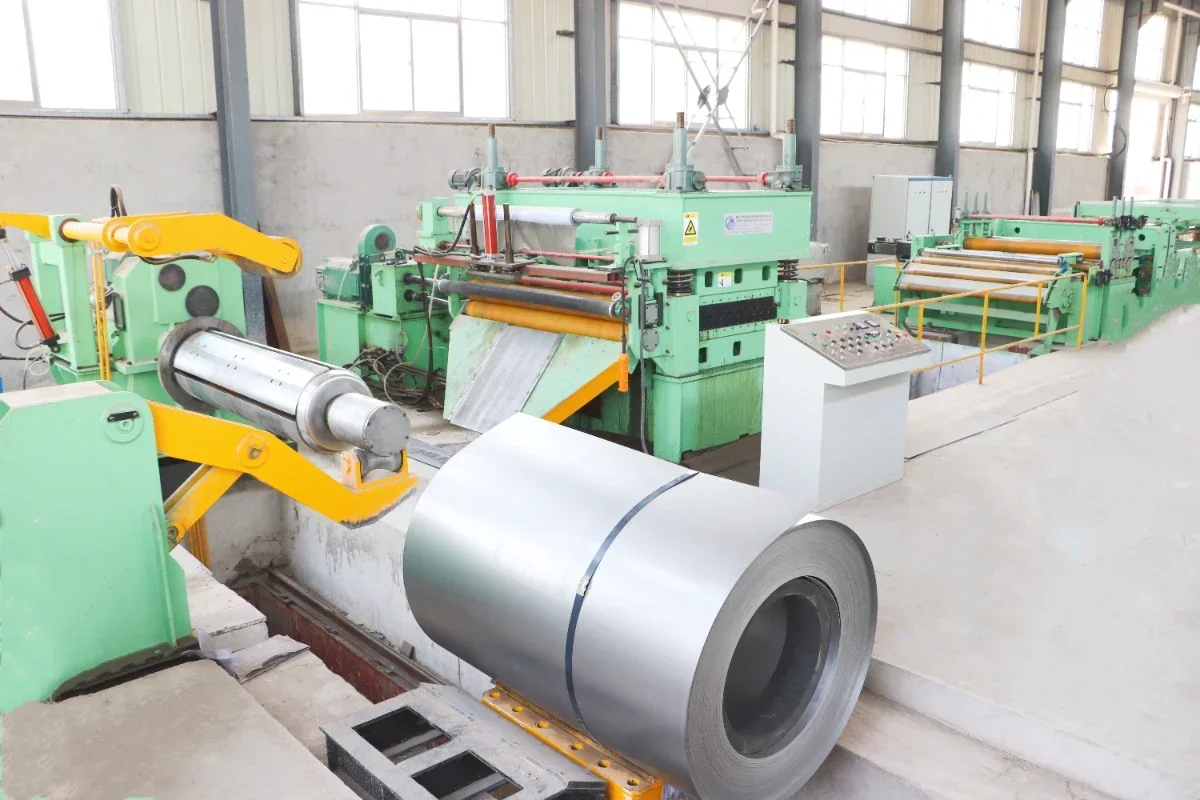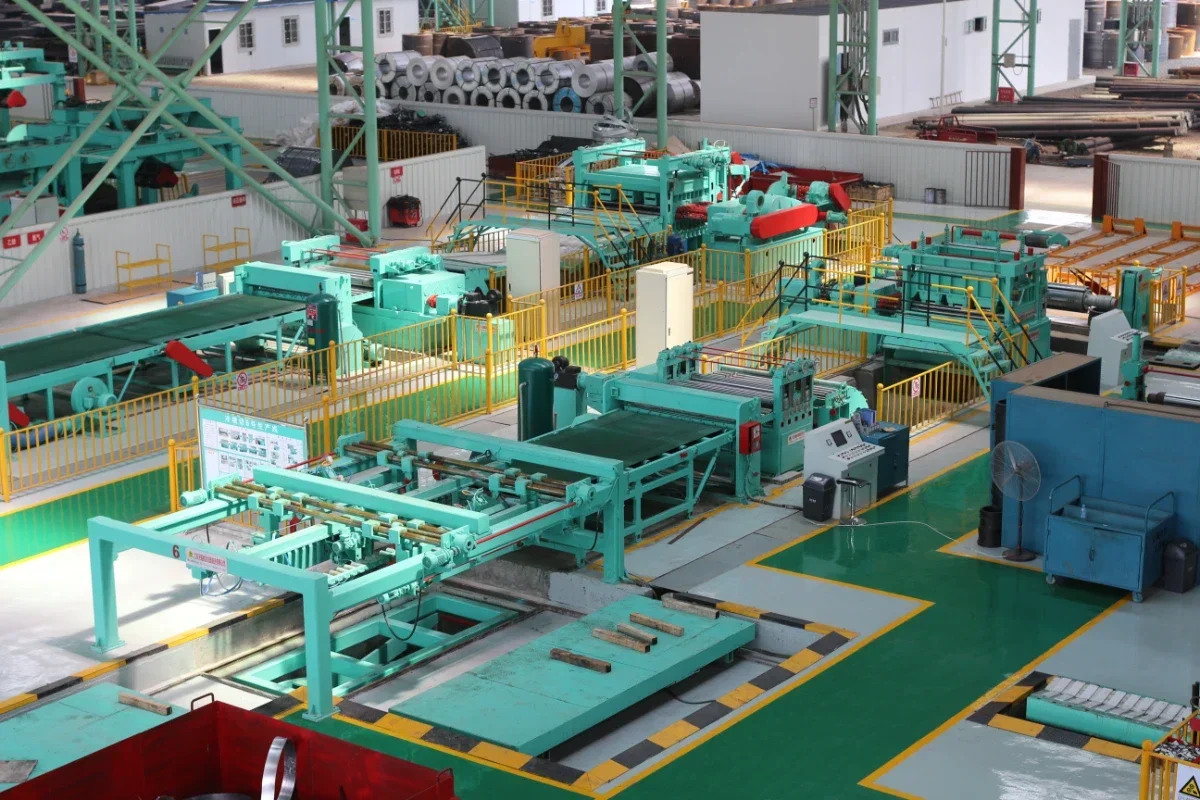In the realm of high-speed manufacturing, the CR High Speed CTL Line stands out as a pinnacle of efficiency and precision. This cutting-edge technology revolutionizes production processes, enhancing speed while maintaining top-notch quality standards. The CR High Speed CTL Line optimizes operations, ensuring seamless performance and unmatched output levels. With its advanced features and innovative design, this system redefines productivity in the manufacturing industry, setting a new standard for excellence.
Benefits of CNC High-Speed Cutting
Production Efficiency
Enhances production efficiency by reducing processing time significantly. This results in quicker turnaround times for projects, allowing businesses to meet tight deadlines and increase overall productivity.
By utilizing CNC high-speed cutting technology, companies can streamline their manufacturing processes, minimizing idle time and maximizing output. This ultimately leads to cost savings and improved competitiveness in the market.
Cutting Accuracy
Improves cutting accuracy leading to higher quality end products. The precision offered by CNC high-speed cutting ensures that each piece is consistent in dimensions and meets exact specifications.
With enhanced cutting accuracy, manufacturers can produce intricate designs with ease, catering to the demands of various industries such as aerospace, automotive, and electronics. This level of precision results in fewer errors and wastage, ultimately saving both time and resources.
Material Versatility
Enables versatility in cutting various materials with precision. CNC high-speed cutting machines are capable of handling a wide range of materials including metals, plastics, composites, and more.
This versatility allows manufacturers to explore new opportunities in different sectors by offering custom solutions tailored to specific material requirements. Whether it's aluminum for aerospace components or acrylic for signage, CNC high-speed cutting delivers consistent results across diverse materials.
CNC Line Advantages for Stainless Steel
Cutting Capabilities
CNC lines offer high-speed cutting capabilities specifically designed for stainless steel, ensuring precise and efficient processing. This technology allows for intricate cuts at rapid speeds, enhancing productivity.
The advanced machinery of CNC lines enables operators to achieve intricate designs and shapes with superior surface finish on stainless steel products. This results in high-quality end products that meet stringent industry standards.
Surface Finish and Edge Quality
With CNC lines, manufacturers can achieve a superior surface finish and edge quality on stainless steel components. The precision of these machines ensures clean cuts without burrs or rough edges, enhancing the overall aesthetics of the final product.
The ability to maintain tight tolerances during the cutting process is crucial for industries working with stainless steel. CNC lines excel in delivering precise cuts, contributing to improved product quality and consistency.
Efficient Processing
One of the key advantages of utilizing CNC lines for stainless steel is the efficient processing of coils with minimal material waste. The automated nature of these systems optimizes material usage, reducing scrap and enhancing cost-effectiveness.
Aluminum Coil Processing Benefits
Fast Processing
Aluminum coil processing offers the advantage of fast and precise operations. By utilizing a high-speed CTL line, manufacturers can efficiently cut and process aluminum coils to meet various industry needs. This speed ensures quick turnaround times for projects, enhancing overall productivity.
Material Integrity
Maintaining material integrity during the cutting process is crucial for achieving optimal results. High-speed CTL lines are designed to handle aluminum coils delicately, preventing any damage or distortion to the material. This preservation of material quality guarantees that the processed aluminum meets the required specifications consistently.
Productivity Enhancement
Streamlining aluminum coil processing operations through a high-speed CTL line significantly enhances productivity. The seamless integration of cutting, leveling, and other processes minimizes downtime and maximizes output. This efficiency boost not only increases production capacity but also improves overall operational efficiency.

Features of Precision Coil Slitters
Advanced Technology
Precision coil slitters incorporate advanced technology to ensure accurate and clean slitting of coils. By utilizing cutting-edge machinery and automation, these slitters can achieve high levels of precision in coil processing.
The integration of advanced technology allows for customizable slitting options, catering to diverse industry requirements. Whether it's adjusting the strip width or enhancing edge quality, precision coil slitters offer flexibility to meet specific needs effectively.
Consistent Strip Width Accuracy
One of the key features of precision coil slitters is their ability to maintain consistent strip width accuracy. This ensures uniformity in the final products, meeting quality standards and enhancing overall operational efficiency.
Precision coil slitters are designed to deliver exceptional edge quality during coil slitting operations. By focusing on maintaining sharp and clean edges, these machines contribute to producing high-quality materials for various applications.
Cold Rolled Aluminum Shear Machine Insights
Efficient Shearing
Cold rolled aluminum shear machines enable efficient shearing of aluminum sheets with high precision. The machines are designed to handle the specific requirements of cold-rolled aluminum, ensuring clean and accurate cuts.
The shearing process involves cutting the aluminum sheets to the desired size without causing any material distortion. This is crucial for industries requiring precise dimensions for their products.
Minimized Distortion
One of the key advantages of using a cold rolled aluminum shear machine is its ability to minimize material distortion during the shearing process. This results in clean and sharp cuts, eliminating any imperfections that may arise from traditional cutting methods.
-
Ensures precise cuts without compromising the integrity of the material.
-
Reduces waste by minimizing errors and rework due to distortion issues.
Enhanced Productivity
By providing quick and reliable solutions for aluminum sheet shearing, these machines significantly enhance productivity in manufacturing processes. The efficiency of these machines allows for faster production cycles and improved overall output.
-
Increases throughput by reducing processing time per sheet.
-
Improves workflow efficiency by streamlining the shearing process.
Decoiling and Recoiling Efficiency
Streamlining Process
Efficient decoiling is crucial for ensuring a smooth material feeding process into the production line. It involves unwinding the coil to provide a continuous feed of material, reducing downtime.
Recoiling plays a vital role in the production process by uniformly winding the processed materials back into coils. This uniform recoiling is essential for easy handling and storage, preventing material damage.
Production Optimization
Optimizing decoiling and recoiling operations significantly enhances overall production efficiency. By maintaining proper tension control during both processes, it minimizes material waste and ensures consistent quality output.
-
Pros:
-
Reduces material waste
-
Improves product quality
-
Equipment Integration
Integrating advanced control systems with the cr high speed ctl line can further enhance efficiency. These systems automate decoiling and recoiling processes, reducing human error and increasing productivity.

Importance of Speed in Slitting
Enhanced Production Deadlines
Focusing on speed in slitting is crucial as it speeds up the process, helping manufacturers meet tight production deadlines effectively. By prioritizing speed, companies can ensure that materials are processed swiftly, allowing for seamless transitions between different stages.
Maintaining a high-speed CTL line enables businesses to keep up with the fast-paced demands of the market. This not only enhances overall productivity but also minimizes delays in delivering finished products to customers promptly.
Operational Efficiency Boost
Improving operational efficiency is another key advantage of emphasizing speed in slitting operations. By reducing turnaround times, companies can streamline their processes and optimize resource utilization. This, in turn, leads to cost savings and increased profitability for the business.
When a CTL line operates at an optimal speed, it minimizes idle time and maximizes output. This results in a more efficient workflow, where materials move swiftly through each stage of the slitting process without bottlenecks or delays.
High Throughput and Productivity
Prioritizing speed in slitting processes ensures high throughput and productivity levels. A fast CTL line enables manufacturers to process larger volumes of materials within a shorter timeframe, leading to increased output and revenue generation.
Precision in Steel Coil Slitting
Advanced Technology
Steel coil slitting processes rely on advanced technology to ensure precise and accurate cuts. By utilizing high-speed CTL lines equipped with cutting-edge machinery, manufacturers can maintain tight tolerances throughout the slitting operation. This technology enables consistent strip width and edge straightness, crucial for producing high-quality steel products.
Tight Tolerances
Maintaining tight tolerances is essential in steel coil slitting to achieve the desired precision in cutting. The advanced machinery used in CTL lines allows for meticulous control over the slitting process, ensuring minimal deviation from the specified measurements. This precision results in uniform strip widths and straight edges, meeting the stringent quality standards required by various industries.
Quality Control Measures
Quality control measures play a pivotal role in enhancing product quality during steel coil slitting. By implementing rigorous inspection protocols at every stage of the process, manufacturers can identify and rectify any deviations promptly. This proactive approach not only ensures consistency in strip dimensions but also minimizes material waste, leading to cost savings and improved overall efficiency.
Efficient Production with High Precision
Optimization Strategies
Combining efficiency and precision is crucial for optimizing manufacturing processes. By streamlining operations and minimizing waste, companies can achieve higher productivity levels. Implementing advanced technologies like automated systems can significantly enhance production efficiency.
Integration of Precision Components
To ensure high-quality output, manufacturers integrate precision components into their production lines. These components, such as high-precision sensors and cutting tools, play a vital role in maintaining accuracy during the manufacturing process. By investing in top-tier equipment, companies can deliver products that meet stringent quality standards.
Operational Efficiency Enhancement
Enhancing overall operational efficiency involves balancing speed and accuracy in production. By prioritizing both aspects, businesses can reduce lead times while maintaining product quality. Implementing lean manufacturing principles and continuous improvement initiatives further boost operational efficiency.

Final Remarks
The completion of the sections highlights the myriad advantages of utilizing CNC high-speed cutting and precision coil slitting in various metal processing operations. The efficiency, accuracy, and speed offered by these technologies underscore their indispensable role in enhancing productivity and maintaining quality standards. From stainless steel to aluminum coil processing, the emphasis on precision and speed resonates throughout the entire production process. The insights shared shed light on the critical aspects that contribute to efficient and effective metal processing operations.
For those seeking to optimize their metal processing workflows and achieve superior results, integrating CNC high-speed cutting and precision coil slitting technologies is paramount. Embracing these advanced solutions not only streamlines production but also elevates the overall quality of output. By prioritizing precision and efficiency, businesses can stay competitive in the ever-evolving metal processing industry.
Frequently Asked Questions
What are the benefits of CNC high-speed cutting?
CNC high-speed cutting offers increased efficiency, precision, and productivity in metal processing. It enables faster production rates, reduces material waste, and ensures superior quality cuts for various materials like stainless steel and aluminum.
How does precision in steel coil slitting contribute to efficient production?
Precision in steel coil slitting ensures accurate dimensions and consistent strip widths, leading to minimal material waste and improved product quality. This process optimizes efficiency by reducing downtime for adjustments and enhancing overall production output.
Why is speed important in slitting processes?
Speed is crucial in slitting processes as it directly impacts productivity and manufacturing costs. High-speed slitting operations enable quicker turnaround times, increased output capacity, and enhanced overall efficiency in metal processing applications.
What are the advantages of CNC line for stainless steel processing?
CNC lines offer precise control over cutting parameters, ensuring clean cuts, smooth edges, and minimal distortion in stainless steel processing. This technology enhances productivity by automating processes, reducing labor costs, and improving the overall quality of finished products.
How does decoiling and recoiling efficiency impact metal processing operations?
Efficient decoiling and recoiling processes optimize material handling, reduce setup times between runs, and ensure continuous production flow. This results in improved operational efficiency, reduced downtime, and enhanced overall productivity in metal processing facilities.

